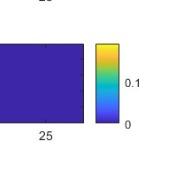Analysis of Multi-Agent Flocking Behaviour
Investigated flocking in autonomous agents using a decentralized control model, through simulations and analysis, revealing sensitivity to parameters and providing insight into designing robots swarms
Created on 29th January 2024
•
Analysis of Multi-Agent Flocking Behaviour
Investigated flocking in autonomous agents using a decentralized control model, through simulations and analysis, revealing sensitivity to parameters and providing insight into designing robots swarms
The problem Analysis of Multi-Agent Flocking Behaviour solves
The decentralized control model enables emergent flocking behavior in groups of robots without complex centralized coordination. Key applications include:
- Environmental monitoring using robot swarms equipped with sensors that efficiently cover large areas for data collection.
- The flocking model coordinates positions and alignments while avoiding fragmentation.
- Search and rescue operations with UAV groups that systematically sweep an area while maintaining coordination, and avoiding gaps.
- Warehouse logistics by applying flocking algorithms to delivery robots for efficient traversal without collisions.
- Space exploration using rover groups to explore larger extraterrestrial regions in a coordinated way.
The insights on stability and convergence rates allow tuning control parameters to achieve desired flocking dynamics for different needs. The project provides a strong foundation for designing large-scale resilient multi-robot systems for complex real-world environments.
By leveraging the validated self-organizing flocking dynamics, engineers can create autonomous swarms to accomplish tasks like exploration, surveillance, and transportation more efficiently and safely. The decentralized scheme is highly scalable and fault-tolerant.
Overall, this research enables applying flocking algorithms to distributed robotic systems across domains, unlocking the benefits of emergent coordination.
Challenges I ran into
One major technical hurdle encountered was instability in the flocking behavior when the agents were initialized with completely random positions and velocities. The decentralized control rules were not able to produce coordinated flocking from such uncontrolled starting conditions.
To overcome this, we implemented spatially clustered initialization where sub-groups of agents were initialized together with similar velocities. This provided sufficient local coordination for the alignment rules to then propagate order throughout the full group. Gradually increasing the initial velocity randomness and group sizes allowed us to robustly achieve global flocking behavior.
Another challenge was the computational complexity of calculating alignments and cohesion in a fully connected network as the number of agents increased into the thousands. To resolve this, we implemented a localized neighborhood radius for each agent's coordination rules rather than having global couplings. This kept the computational cost manageable while still resulting in emergent flocking across large swarms.
Through insights like these about the interplay of spatial structure, randomness, and computational scaling, we systematically improved the decentralized control model to reliably demonstrate coordinated flocking behaviors even in large-scale stochastic simulations. The project taught us the importance of designing interactions in multi-agent systems to balance locality with global order emergence.
Technologies used
